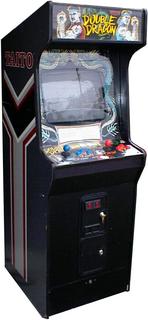I currently use a Double Dragon cabinet for playing games that I don't have dedicated machines for. This is what they look like:
http://www.arcade-museum.com/game_detail.php?game_id=7619
The reason I use it is because it is easy enough (but risky to the monitor neck board) to rotate the monitor so that I can play horizontal and vertical games in the same cab. I don't have enough room for more machines, so this is really important. It also has a drawer in the front that makes it really easy to swap out boards.
Anyways, rotating the monitor is enough of a pain and risky to the neck of the monitor that I only really do it maybe once a week. I'd really like to be able to switch multiple times a day without too much work and risk. I'm contemplating building a custom cabinet to achieve this with the following spec:
1) Must look like a classic cab and working with a 19" crt. The Double Dragon cab is a good example of what I'm going for (except for the god-awful artwork!

)
2) Would like to take as much space as I can in the front for board storage. I don't need a coin door, etc. I can put a bunch of boards in it and either use a jamma switcher or just move a jamma cable from board to board when I want to switch games.
3) Would be nice to have a motor set up to rotate the monitor. Having a switch hooked up to switch is fine. I'm not too worried about auto-degaussing or anything like that since I'll power the machine off between board swaps. I'd also be fine with starting with a geared hand-crank or similar. I just don't want to have to pick up the monitor to rotate it.
4) Simple wooden control panel (like Defender or Double Dragon so that it's easy to make more control panels. With the Double Dragon, I have two control panels that are the original control panels except that one of them has 4-way Wico sticks and the other has 8-way Wico sticks. I'll eventually build panels for Sinistar and other games as I get around to it.
It's important to me that this look like a classic machine. I'm not interested in LCDs to make the rotating easier.
So given all that, what machine drawings would you start with? I've though about basically copying the Double Dragon cabinet but with modifications to suit the board storage and the rotating monitor. Any other suggestions?
Also, what software do you guys typically use when designing something like this? I'll probably start with Sketchup, and I'll likely start by building miniature prototypes.
Fortunately, I have a friend that's handier with all this kind of stuff than I am to help out!





 Home
Home Help
Help Search
Search Login
Login Register
Register
 Send this topic
Send this topic Print
Print



